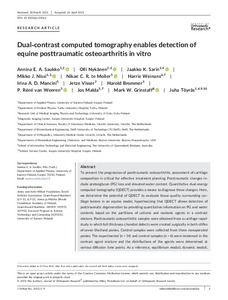Dual-contrast computed tomography enables detection of equine posttraumatic osteoarthritis in vitro
Mancini Irina AD; Saukko Annina EA; Visser Jetze; Nissi Mikko J; Töyras Juha; van Weeren P Réné; Brommer Harold; Grinstaff Mark W; Nykänen Olli; Weinans Harrie; Malda Jos; Sarin Jaakko K; te Moller Nikae CR
Dual-contrast computed tomography enables detection of equine posttraumatic osteoarthritis in vitro
Mancini Irina AD
Saukko Annina EA
Visser Jetze
Nissi Mikko J
Töyras Juha
van Weeren P Réné
Brommer Harold
Grinstaff Mark W
Nykänen Olli
Weinans Harrie
Malda Jos
Sarin Jaakko K
te Moller Nikae CR
WILEY
Julkaisun pysyvä osoite on:
https://urn.fi/URN:NBN:fi-fe2021093048713
https://urn.fi/URN:NBN:fi-fe2021093048713
Tiivistelmä
To prevent the progression of posttraumatic osteoarthritis, assessment of cartilage composition is critical for effective treatment planning. Posttraumatic changes include proteoglycan (PG) loss and elevated water content. Quantitative dual-energy computed tomography (QDECT) provides a means to diagnose these changes. Here, we determine the potential of QDECT to evaluate tissue quality surrounding cartilage lesions in an equine model, hypothesizing that QDECT allows detection of posttraumatic degeneration by providing quantitative information on PG and water contents based on the partitions of cationic and nonionic agents in a contrast mixture. Posttraumatic osteoarthritic samples were obtained from a cartilage repair study in which full-thickness chondral defects were created surgically in both stifles of seven Shetland ponies. Control samples were collected from three nonoperated ponies. The experimental (n = 14) and control samples (n = 6) were immersed in the contrast agent mixture and the distributions of the agents were determined at various diffusion time points. As a reference, equilibrium moduli, dynamic moduli, and PG content were measured. Significant differences (p < 0.05) in partitions between the experimental and control samples were demonstrated with cationic contrast agent at 30 min, 60 min, and 20 h, and with non-ionic agent at 60 and 120 min. Significant Spearman's rank correlations were obtained at 20 and 24 h (rho = 0.482-0.693) between the partition of cationic contrast agent, cartilage biomechanical properties, and PG content. QDECT enables evaluation of posttraumatic changes surrounding a lesion and quantification of PG content, thus advancing the diagnostics of the extent and severity of cartilage injuries.
Kokoelmat
- Rinnakkaistallenteet [19218]
